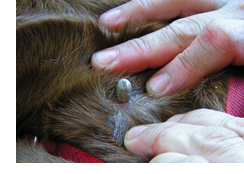
Tick season is in full swing and that means getting ready to do battle with those nasty parasites lurking around in the grass and bushes of your fur friend’s favourite park! Knowledge and prevention are your best weapons and we’re here to arm you with both!
There’s nothing nice about a paralysis tick. In fact, they are among the most dangerous parasites that can affect your pet and very common on the Gold Coast. You may use preventative treatments and even do daily tick checks just to be safe, but sometimes one gets through. So what do you do?
What happens when ticks attach?
Paralysis ticks are very mobile before attaching to your pet. They can move all over the body before settling in one place. Once embedded, the tick’s head firmly attaches to the skin and begins to feed on blood. But that is not all it is doing. While feeding, it also excretes toxic saliva with a lethal poison directly into the bloodstream!
The injection of toxins usually occur on day 3 of attachment and peak around day 5-6. This is why early detection is paramount in your pet making a full recovery.
Checking for ticks
We cannot recommend daily tick checks enough, even if you do use tick prevention treatments.
• Start at the tip of the animal’s nose and work your way right down to the end of the tail.
• Look and feel for raised bumps on the coat or skin – these can be black/brown/grey in colour.
• Run your hand through their coat with your fingertips.
• Ensure you check everywhere, including in the ears, around and inside the lip area, between toes, around the rectum, and under armpits.
Most ticks are found forward of the front legs, most commonly around the face, neck, ears and lips, under the collar and between the toes.
What to do when finding a tick
Perhaps you have heard that removing the tick will inject more poison, however it is now believed that removing the tick is better than leaving it on. If you find a tick, remove it immediately. Simply use a pair of tweezers or forceps, grasping around the tick’s head or base (the area connected to the dog) and pull off firmly. If the head remains in the skin the body will treat it like a foreign body and it will scab over and eventually fall off.
Whether the animal is showing signs of paralysis or not it is best to contact Pet Doctors immediately. Make sure you keep your pet calm and do not give them any food or water.
Clinical signs
STAGE 1: inappetance, lethargy, occasional retching or vomiting, change in bark tone.
STAGE 2: lethargy, vomiting, panting when breathing, unsteady hind legs.
STAGE 3: very lethargic and flat, abnormal breathing pattern (grunting on exhalation), unable to walk properly, falling over etc.
STAGE 4: Cannot stand up or lift body, severe respiratory distress, possible heart complications.
STAGE 5: severe respiratory complications, animal completely immobilised, impending death due to paralysis of respiratory muscles, heart failure and aspiration pneumonia.
From the time of the first clinical signs, your pet could be dead in less than a couple of days if not treated immediately. If you suspect your pet has any of these symptoms, please call Pet Doctors immediately. The sooner treatment is administered, the more likelihood of survival.
Prevention
• Use a product that offers tick prevention, such as Frontline Spray (for cats) or Advantix for dogs (note: Advantix is TOXIC to cats). NexGard and Bravecto are two new flea and tick treatments that can be given to dogs orally.
• Complete a tick search every day, particularly through spring and summer.
• Clip your pet’s coat for easier tick identification.
• Don’t let your dog wander through bushland or long grass.
• Know the signs of tick paralysis!!!

